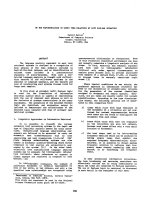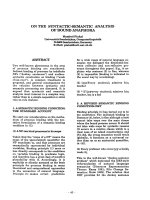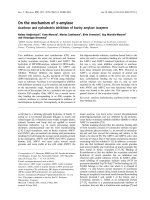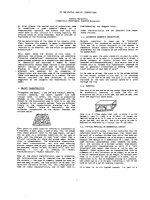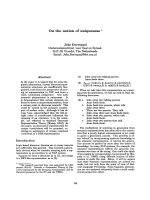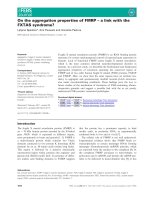báo cáo khoa học: "On the genetic determinism of muscular hypertrophy in the Belgian White and Blue cattle breed" pptx
Bạn đang xem bản rút gọn của tài liệu. Xem và tải ngay bản đầy đủ của tài liệu tại đây (421.47 KB, 10 trang )
On
the
genetic
determinism
of
muscular
hypertrophy
in
the
Belgian
White
and
Blue
cattle
breed
I.
Experimental
data
(*)
R.
HANSET
C.
MICHAUX
Faculte
de
Médecine
vétérinaire
(U.LG)
45,
rue
des
V étérinaires,
B-1070
Bruxelles,
Belgique
Summary
The
inheritance
of
muscle
hypertrophy
has
been
studied
in
an
experiment
where
Fi
cows
(Belgian
Blue
X
Friesian)
are
backcrossed
to
Belgian
Blue
sires.
The
total
weight
of
the
most
important
muscles,
in
calves
slaughtered
at
the
constant
weight
of
84
kg,
was
the
criterion
for
muscle
development.
The
distribution
of
this
variable
in
the
backcross
shows
a
clear
bimodality
corresponding
to
the
segregation
of
2
alleles,
in
equal
proportions.
The
fitting
of
a
monogenic
model,
by
the
Weighted
Least
Squares
method,
has
led
to
the
estimations
of
gene
effect
and
dominance
deviation.
The
difference
between
the
2
homozygotes
amounts
to
more
than
6 times
the
standard
deviation
within
genotype.
It
is
concluded
that
a
major
gene
is
involved
in
the
determination
of
muscle
hypertrophy
in
the
Belgian
Blue
cattle
breed
and
that
regarding
the
phenotypic
expression
considered
in
this
study
this
gene
behaves
as
a
partially
recessive
gene,
the
heterozygote
being
near
the
homozygous
normal.
The
symbol
mh
for
muscular
hypertrophy
is
proposed
to
identify
this
major
gene.
Key
words :
Belgian
White
and
Blue
breed,
muscle
hypertrophy,
inheritance,
major
gene,
cattle.
Résumé
Le
déterminisme
génétique
de
?hypertrophie
muscu’aire
dans
la
race
bovine Blanc-Bleu
Belge.
I. -
Données
expérimentales
L’hérédité
de
l’hypertrophie
musculaire
est
étudiée
dans
une
expérience
où
des
vaches
Fi,
issues
de
taureaux
de
race
Blanc-Bleu
Belge
et
de
vaches
Frisonnes
sont
croisées
en
retour
à
des
taureaux
de
race
Blanc-Bleu
Belge.
Le
critère
de
développement
musculaire
a
été
le
poids
total
des
muscles
les
plus
plus
importants
obtenu
sur
des
veaux
abattus
au
poids
constant
de
84
kg.
La
distribution
de
cette
variable
dans
le
croisement
de
retour
est
nettement
bimodale
ce
qui
correspond
à
la
*
This
work
is
supported
by
the
« Institut
pour
l’Encouragement
de
la
Recherche
Scientifique
dans
l’Industrie
et
I’Agriculture
(I.R.S.I.A.).
ségrégation,
en
proportions
égales,
d’une
paire
d’allèles.
L’ajustement
d’un
modèle
mono-
génique
par
la
méthode
des
moindres
carrés
pondérés
a
conduit
à
l’estimation
de
l’effet
du
gène
et
de
la
déviation
de
dominance.
La
différence
entre
homozygotes
s’élève
à
plus
de
6
fois
la
déviation
standard
«
intra-génotype
».
On
en
conclut
qu’un
gène
majeur
est
impliqué
dans
la
détermination
de
l’hypertrophie
musculaire
dans
la
race
Blanc-Bleu
Belge
et
que,
pour
le
critère
utilisé,
ce
gène
se
comporte
comme
un
récessif
partiel,
l’hétérozygote
étant
plus
près
de
l’homozygote
normal.
Le
symbole
mh
est
proposé
pour
identifer
ce
gène
majeur.
Mots
clés :
Race
Blanc-Bleu
Belge,
hypertrophie
musculaire,
hérédité,
gène
majeur,
bovin.
I.
Introduction
The
genetic
determinism
of
muscle
hypertrophy
in
cattle
has
been
considered
according
to
the
authors,
as
due
either
to
one
single
gene
(dominant
complete
or
partial,
recessive
complete
or
partial)
or
to
more
than
one
gene
(see
the
review
by
M
ENISSIER
,
1982).
On
the
other
hand,
in
most
of
the
genetic
analyses
of
this
condition
so
far
published,
the
distribution
of
the
animals
into
phenotypic
classes
was
based
on
a
subjective
appraisal
of
the
conformation.
In
the
experiment
we
report
in
this
paper,
the
degree
of
muscling
was
evaluated
by
the
total
weight
of
the
most
important
muscles.
So
in
this
study,
a
well
defined
phenotype,
measured
on
a
metric
scale,
replaces
a
sometimes
ambiguous
phenotypic
trait.
t.
The
proof
of
the
segregation
of
a
major
gene,
if
any,
would
then
be
the
straight-
forward
outcome
of
the
inspection
of
the
distribution
of
this
quantitative
variable
considered
as
an
expression
of
the
muscle
hypertrophy.
Furthermore,
estimations
of
the
gene
effect
and
of
the
dominance
deviation
for
this
phenotypic
criterion
are
then
possible
through
the
fitting
of
the
appropriate
mathematical
model.
Partial
ac-
counts
of
this
experiment
have been
presented
earlier
(H
ANSET
,
1982 a,
b).
II.
Material
and
methods
The
calves
of
both
sexes
were
reared
on
the
same
diet
(milk
from
the
bucket)
tilt
the
final
weight
of
84
kg.
They
were
then
slaughtered
and
the
halfcarcasses
dissected.
The
average
final
weight
was
in
fact
83.9
kg
(S
= 4.0)
and
the
final
age
82.1
days
(S
=
25.3).
These
calves
belonged
to
the
following
genetic
types :
1)
dairy
(European
Friesian)
-D-
(n
=
5) ;
2)
double-muscled
(Belgian
White
and
Blue)
- DM -
(n
=
30),
born
from
double-muscled
cows
bred
to
3
double-muscled
A.I.
sires
(from
sire
De,
n
=
10 ;
from
sire
Na,
n
=
8 ;
from
sire
Te,
n
=
12) ;
3)
first-cross
- F
I
-
(n
= 7) ;
born
from
Friesian
cows
bred
to
sire
De ;
4)
backcross
- BC -
(n
= 60) ;
F,
cows
(14
daughters
of
sire
De
and
20
daugh-
ters
of
sire
Te)
were
bred
to
their
respective
fathers
De
(n
=
21)
and
Te
(n
=
23)
and
to
2
other
double-muscled
bulls :
Na
(n
=
12)
and
Ch
(n
=
4).
All
these
sires
belonged
to
the
Belgian
White
and
Blue
breed
and
are
of
the
double-muscled
type.
These
F1
cows
had
a
typical
dual-purpose
phenotype.
The
calves
from
the
sires
De
and
Na
were
dissected
between
1972
and
1978
and
the
calves
from
the
sires
Te
and
Ch
between
1979
and
1984.
The
calves
were
reared
in
the
constant
environment
of
an
experimental
station,
throughout
the
entire
period.
The
muscling
criterion
is
the
sum
of
the
weights
(in
the
left
half-carcass)
of
the
most
significant
muscles,
their
share
in
the
whole
musculature
amounting
to
75
p.
100
approximately.
Each
total
muscle
weight
was
adjusted
to
a
common
final
weight
of
84
kg.
The
following
muscles
or
groups
of
muscles
are
included
in
this
sum :
-
Neck
region :
Rhomboideus,
Splenius,
Semispinalis
capitis,
Spinalis
dorsi,
Longissimus
dorsi.
-
Thorax
region :
Latissimus
dorsi,
Pectorales
superficialis
et
profundi,
Serra-
tus
ventralis.
-
Thoracic
limb :
Supraspinatus,
Infraspinatus,
Teres
minor,
Deltoideus,
Sub-
scapularis,
Teres
major,
Biceps
brachü,
Brachialis,
Triceps
brachü
(caput
longum,
laterale),
Antebrachü.
-
Pelvic
limb :
Gluteus
medius,
Tensor
fasciae
latae,
Biceps
femoris,
Vastus
lateralis,
Rectus
femoris,
Vastus
medialis,
Semitendinosus,
Sartorius,
Gracilis,
Semi-
membranosus,
Pectineus,
Adductor
femoris,
Gastrocnemius,
Extensor
group,
Flexor
group,
Psoas
major,
Psoas
minor,
Iliacus.
A
detailed
study
of
the
hypertrophy
of
single
muscles
will
be
presented
in
an
independent
paper.
The
data
of
both
sexes
were
pooled.
There
was
no
difference
between
sexes
regarding
the
total
muscle
weight,
as
a
consequence
of
the
constraint
of
the common
final
weight.
The
normality
of
the
frequency
distributions
was
tested
by
the
K
OLMO
-
GOROV
-S
MIRNOV
procedure
D
(Durbin’s
version)
for
samples
of
size
greater
than
50
and
by
the
W
test
(S
HAPIRO
&
W
ILK
,
1965)
for
samples
of
size
smaller
than
50,
this
latter
test
being
in
this
instance
more
powerful
than
the
former
(S
TEPHENS
,
1974).
The
Statistical
Analysis
System
(SAS)
package
was
used
to
perform
these
tests.
The
homogeneity
of
variance
was
tested
by
the
Bartlett’s
test
(S
NEDECOR
&
CocxRnrr,
1980).
On
the
other
hand,
in
the
case
of
the
backcross
data,
the
sample
obtained
can
be
considered
as
a
random
sample
of
a
mixture
with
proportions
p
and
q
of
two
univariate
normal
distributions
with
means
It1
and
1
-t
2
and
a
common
variance
cr2.
The
likelihood
of
the
sample
of
size
n
is
given
by :
The
log-likelihood
of
the
sample
becomes :
The
combination
of
estimates
(P.
1’
1
-t2l
(j
2,
p)
which
maximizes
the
log-likelihood
function
is
found
iteratively.
To
this
end,
the
Maximum
Likelihood
Estimation
Pro-
gram
of
K
APL
AN
&
E
LST
ON
(1978)
was
used.
III.
Results
and
discussion
Table
1
gives,
for
each
genetic
type,
the
sample
size,
the
mean,
the
standard
deviation
and
for
the
larger
classes,
a
test
of
normality
of
the
muscling
criterion
defined
above.
The
distribution
of
the
total
muscle
weight
is
graphed
in
figure
1 :
A)
for
the
calves
born
from
double-muscled
parents
(DM
X
DM) ;
B)
for
the
calves
born
from
the
backcross
to
the
double-muscled
parent
(DM
X
Fi
).
Bimodality
is
very
obvious
for
the
results
of
the
backcross.
It
is
expressed
in
a
large
standard
deviation
and
a
highly
significant
test
of
normality.
As
a
consequence,
this
distribution
can
be
resolved
into
2
distributions,
either
visually
or
by
the
fitting
of
2
normal
distributions
by
a
maximum
likelihood
procedure.
Both
approaches
lead
to
the
same
result.
Considering
figure
1,
the
cut-off
point
is
lying
between
16
and
kg.
The
mean,
the
standard
deviation
and
the
test
of
normality
of
the
2
compo-
nent
distributions
are
given
in
table
1
where
they
are
referred
to
as
BC
1
and
BC
2.
The
non-normality
in
BC
1 is
due
to
5
weakened
animals,
which
reached
the
final
weight
at
the
average
age
of
116
days,
far
above
the
mean
of
82
days.
If
the
2
observed
variances
for
BC
1 and
BC
2 are
significantly
different,
nevertheless,
the
test
of
homogeneity
of
variance
applied
to
the
five
estimâtes
(D,
DM,
Fi,
BC
1
and
BC 2)
is
not
significant
(0.25
>
P
>
0.10).
Therefore,
a
common
variance
is
admitted
for
BC
1
and
BC
2
and
below
for
the
five
classes.
On
the
other
hand,
the
maximum
likelihood
estimates
and
their
standard
errors
are :
The
antimode
of
this
compound
distribution
is
halfway
between
the
2
means,
( !1
and
[12
and
equal
to
16.487
kg.
The
BC1
and
BC2
means
compare
very
well
with
the
F1
and
DM
means
respectively
(tabl.
1).
As
indicated
above,
the
data
of
both
sexes
were
pooled.
The
data
were
also
pooled
over
years
and
the
reason
is
found
in
figure
2
which
shows
the
yearly
variation
of
the
average
total
muscle
weight
for
the
3
classes :
DM,
BC
2 and
BC
1.
Bimodality
is
apparent
because
the
difference
between
the
2
subpopulation
means
is
greater
than
4
times
the
common
standard
deviation
and
this
is
far
more
than
the
minimum
requirement
of
2
standard
deviations
(M
ERAT
,
1967,
1968).
The
2
dis-
tributions
are
the
expression
of
the
segregation
in
equal
proportions
of
a
single
pair
of
genes
as
in
the
classical
backcross
to
the
recessive
parent.
It
seems
therefore
quite
reasonable
to
consider
these
2
subpopulations
as
2
genetic
classes.
As
no
single
symbol
was
agreed
upon
until
now
to
identify
this
gene,
we
propose
the
symbol
mh
for
muscular
hypertrophy
and
+
for
the
normal
allele.
Accordingly,
the
3
genotypes
at
the
mh
locus
are
written
as
follows :
mhl mh ;
mhl + ;
+/+.
0
If
the
segregation
of
a
single
major
gene
is
admitted,
the
question
is
then
to
know
whether
the
gene
for
double-muscling
is
completely
recessive
or
not.
The
gene
effect
and
the
dominance
deviation
were
estimated
through
the
fitting
to
the
data
of
a
monogenic
model.
Regarding
their
degree
of
muscling,
the
2
breeds
used
in
this
cross
-
the
Friesian
(D)
and
the
Belgian
White
and
Blue
(DM) —
could
differ
not
only
for
the
gene
for
muscle
hypertrophy
but
also
for
polygenes.
Bearing
this
in
mind,
one
can
write
down
the
expectations
corresponding
to
the
genetic
types
(tabl.
2).
The
breed
difference
is
written :
2
a
stands
for
the
difference
in
muscling
between
the
genotypes
mhlmh
and
+/+
and
2
m
for
the
difference
due
to
polygenes.
The
expectation
for the
Fi
mean
is
equal
to :
Il
+
d,
with
d
for
the
dominance
deviation.
The
Weighted
Least
Squares
equations
leading
to
the
estimations
of
the
elements
of
the
model
are
given
in
the
appendix.
The
Weighted
Least
Squares
solutions
and
their
standard
errors
are
given
in
table
2
as
well
as
the
observed
and
the
expected
means.
The — m —
effect
of
the
model
is
positive
but
not
significantly
different
from
zero.
This
result
is
unexpected
but
the
non-significance
is
probably
due
to
the
small
size
of
the
samples.
On
the
other
hand,
the
-
a
-
and
-
d
-
effects
are
signi-
ficant.
Since,
the
FI
cows
were
daughters
of
only
2
sires,
some
confounding
is
pos-
sible.
Moreover,
these
estimates
concern
a
particular
criterion,
the
total
muscle
weight,
measured
at
a
given
age
for
a
given
jearing
system.
Nevertheless,
one
may
safely
conclude
that,
for
the
criterion
of
muscling
used
in
this
study,
the
major
gene
for
muscle
hypertrophy
behaves
as
a
partially
recessive
gene,
the
first
copy
of
the
mh
gene
having
a
distinctly
smaller
effect
than
both
copies
(fig.
3).
The
degree
of
overlapping
of
the
distributions
corresponding
to
the
genotypes
/
MA/+
and
mhlmh
is
quite
small
and
of
the
order
of
2
p.
100
(2
X
1,12
p.
100).
The
heterozygote
(mhl+)
is
near
the
homozygous
normal
(+/+)
and
the
propor-
tion
of
overlapping
of
these
two
genotypes
amounts
to
23.4
p.
100
(2
X
11.7
p.
100).
These
latter
2
genotypes
exhibit
the
conventional
conformation
(fig.
3 -
area
at
the
left
of
the
vertical
line)
while
the
homozygote
mhlmh
has
a
distinct
conformation
although
with
varying
degrees
as
can
be
inferred
from
the
variation
of
the
muscle
weight
within
this
class
(fig.
3 -
area
at
the
right
of
the
vertical
line).
Our
results
support
the
hypothesis
of
a
single
partially
recessive
gene
put
forward
previously,
but
on
the
basis
of
subjective
data,
by
authors
as
M
AGLIANO
(1933),
WEBER
&
I
BSEN
(1934),
K
IDWELL
et
al.
(1952),
H
ANSET
(1967,
1972),
R
OLLINS
et
al.
(1972),
(see
the
review
by
M
ENISSIER
,
1982).
Received
October
lst,
1984.
Accepted
February
27,
1985.
Acknowledgements
Drs
M.
A
NSA
Y,
C.
HAN
ZEN
,
M.
J
ANDRA
IN,
K.N.
KI
NTABA
,
P.
LE
ROY
and
J.
MA
RCOURT
are
thanked
for
their
valuable
assistance.
The
technical
skill
of
Mr
A.
B
REULS
DE
T
IECKEN
and
of
Miss
J.
R
OUPAIN
has
been
greatly
appreciated.
The
2
referees
are
thanked
for
their
constructive
suggestions.
References
D
URBIN
J.,
1961.
Some
methods
of
constructing
exact
tests.
Biometrika,
48,
41-55.
H
ANSET
R.,
1967.
Le
problème
de
l’hypertrophie
musculaire
ou
caractère
«
culard
» dans
la
race
bovine
de
Moyenne
et
Haute
Belgique.
Ann.
Méd.
Vét.,
111,
140-180.
H
ANSET
R.,
1972.
L’interférence
du
caractère
culard
et
de
la
sélection
basée
sur
la
confor-
mation
dans
la
race
bovine
de
Moyenne
et
Haute
Belgique.
Ann.
Méd.
Vét.,
116,
27-56.
H
ANSET
R.,
1982
a.
Muscular
hypertrophy
as
a
racial
characteristic :
the
case
of
the
Belgian
Blue
Breed.
In :
K
ING
J.W.B.
and
M
ENISSIER
F.
(ed.),
Muscle
hypertrophy
of
genetic
origin
and
its
use
to
improve
beef production,
437-449.
Martinus
Nijhof,
The
Hague.
H
ANSET
R.,
1982
b.
Major
genes
in
animal
production.
Examples
and
perspectives :
cattle
and
pigs.
2nd World
Congress
of
Genetics
Applied
to
Livestock
Production.
Madrid,
4-8
October,
1982,
6,
439-453.
Editorial
Garsi,
Madrid.
K
APLAN
E.B.,
E
LSTON
R.C.,
1978.
A
subroutine
package
for
Maximum
Likelihood
Estimation
(MaxLik).
Dept.
of
Biostatistics.
Univ.
North
Carolina,
Chapel-Hill,
Institute
of
Statistics.
Mimeo
Series
n°
823.
K
IDWELL
J.F.,
V
ERNON
E.H.,
C
ROWN
R.M.,
S
INGLETARY
C.B.,
1952.
Muscular
hypertrophy
in
cattle.
J.
Hered.,
43,
62-68.
M
AGLIANO
E.,
1933.
Indagni
circa
il
comportamiento
genetico
della
cosidetta
« groppa
di
cavello
» nei
bovini
di
razza
piemontese.
Clinica
Vet.
Milan,
11,
124-139.
M
ENISS
I
ER
F.,
1982.
Present
state
of
knowledge
about
the
genetic
determination
of
muscular
hypertrophy
or
the
double-muscled
trait
in
cattle.
In :
KING
J.W.B.
and
M
ENISSIER
F.
(ed.),
Muscle
hypertrophy
of
genetic
origin
and
its
use
to
improve
beef production,
387-428.
Martinus
Nijhof,
The
Hague.
M
ERAT
P.,
1967.
Moyens
possibles
de
déceler
des
gènes
influant
sur
la
variance
phénotypique.
Ann.
Biol.
Anim.
Bioch.
Biophys.,
7,
489-493.
M
ERAT
P.,
1968.
Distributions
de
fréquences,
interprétation
du
déterminisme
génétique
des
caractères
quantitatifs
et
recherche
de
« gènes
majeurs
».
Biometrics,
24,
277-293.
R
OLLINS
W.C.,
T
ANAKA
M.,
N
OTT
C.F.G.,
T
HIESSEN
R.B.,
1972.
On
the
mode
of
inheritance
of
double
muscled
conformation
in
bovines.
Hilgardia,
41,
433-456.
S
HAPIRO
S.S.,
W
IL
x
M.B.,
1965.
An
analysis
of
variance
test
for
normality
(complete
samples).
Biometrika,
52,
591-611.
S
NEDECOR
G.W.,
C
OCHRAN
W.G.,
1980.
Statistical
Methods,
7th
ed.,
The
Iowa
State
Uni-
versity
Press,
Ames,
Iowa,
U.S.A.
S
TATISTICAL
A
NAL
YS
IS
SYS
T
EM
(SAS).
SAS
user’s
guide
1979.
SAS
Institute
Inc.,
Cary,
North
Carolina.
S
TEPHENS
M.A.,
1974.
E.D.F.
(Empirical
Distribution
Function)
statistics
for
goodness
of
fit
and
some
comparisons.
J.
Am.
Stat.
Ass.,
69,
730-737.
WEBER
A.D.,
I
BSEN
H.L.,
1934.
The
occurrence
of
the
double
muscle
character
in
pure-bred
beef
cattle.
Proc.
Amer.
Soc.
Anim.
Prod.,
27,
228-232.
Appendix
Estimation
by
Weighted
Least
Squares
of
gene
effect
and
dominance
deviation
The
residual
Sum
of
Squares
corresponding
to
the
expectations
of
table
2
(see
text)
is
given
by :
From
the
partial
derivatives
of
this
sum
with
respect
to
the
4
unknowns :
[
1,
m,
a,
d,
the
following
set
of
Least
Squares
equations
is
obtained
(ni,
nm
are
the
numbers
of
individuals
in
each
genetic
class).
The
residual
variance,
G2,
considered
as
being
the
same
for
all
classes,
is
compu-
ted
from
the
residual
Sum
of
Squares
and
the
standard
errors
of
the
estimates
are
given
by
Ce
!/C!2
where
C
2b
is
the
corresponding
diagonal
elements
in
the
inverse
matrix.


